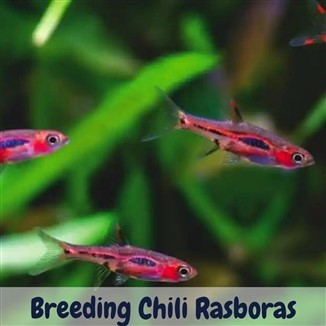Chili Rasboras – or Mosquito Rasbora – are one of the most popular schooling fish for aquarists. Due to their colorful and vibrant looks, chili rasboras make an excellent addition to all community tanks. And even better? Taking care of chili rasboras is not as challenging as you might think!
Still, breeding chili rasboras is not that easy, particularly for beginners. In case you do not know how to keep this species bountiful, let’s keep scrolling and see what the experts have to say!
Contents
Chili Rasbora Breeding

While it is true that chili rasboras are spawners, they cannot lay eggs consistently if the conditions are less than favorable. Therefore, you must create a supportive habitat where these fish can mate and female chili rasboras can comfortably give birth to their offspring.
First off, consider preparing a separate tank for breeding. Unlike most animals, chili rasboras are unable to tell the difference between their own kids and their prey. Subsequently, baby chili rasboras may become their own parents’ diet.
Ensuring that parental chili rasboras do not come close and attack newborns is crucial if you want to maintain their birth rate. As long as female chili rasboras lay the eggs, you are to remove them from the breeding tank. By cutting off contact between these two groups, the eggs stand a higher chance of being hatched.
Secondly, an ideal ratio of male to female chili rasboras must be set in place. Usually, you need 2 females per 1 dominant male in the breeding tank. Be on the outlook for healthy, well-conditioned individuals, as they are the ones most likely to mate.
Thirdly, make sure the eggs have somewhere to lean on while waiting to hatch. Either faux grass or live plants at the bottom of the tank will suffice. Since the eggs will be scattered around, you will need the vegetation layer to cover the entire surface of the floor.
Last but not least, keep a special diet for newly hatched chili rasboras ready. Usually, the fish will come out of their eggs within 2-4 days.
After feeding on the egg sac, chili rasboras will need something more solid and nutritious. Infusoria-sized food is highly recommended. Once the fish grow bigger, you can switch to microworms or vinegar eels.
Chili Rasbora Lifespan, Appearance, Size.
Lifespan
Since chili rasboras are rather tiny, some aquarists assume that they cannot live longer than a few years. This cannot be further from the truth. An average chili rasbora may survive up to 8 years if the tank conditions are optimal.
With clean water and as little stress as possible, chili rasboras may surprise you with their longevity.
Appearance

Chili rasboras are slender and elongated, with two large eyes featured rather dominantly at the head. They come in various shades of pink and red, creating an outstanding hue.
Running across a chili rasbora’s body is a red and black stripe, illuminating brightly in the dark. Given their captivating look, it is no wonder why chili rasboras are such a babe in the tank.
Size
Chili rasboras are known to be among the smallest tank fish. With a total length of no more than 0.7 inches, chili rasboras rely on their school for safe traveling.
While there are some chili rasboras longer than 0.7 inches, they are few and far between.
Chili Rasbora Care Guide
Tank conditions
Due to their tiny size, chili rasboras will do fine in any tanks containing at least 5 gallons of water. If you are using a community tank, then there is no worry about whether these nano fish can fit in.
But still, if you truly want your school of chili rasboras to thrive, consider an average-size tank where they can move in groups comfortably.
As for the water parameters, the recommended temperature ranges from 20 degrees Celcius to 28 degrees Celcius, which is equivalent to 68 degrees Fahrenheit and 82 degrees Fahrenheit respectively.
Slightly acidic water with slow-moving streams controlled by the filters is best cut out for chili rasboras.
Food
Chili rasboras feed on tinier animals. Anything from insects and worms to baby brine shrimp and planktons will make a reasonable diet for these fish. But do not let your fish take in only natural protein! If you want to balance their food intake, give them some small pellets and fish flakes as well.
Behavior & Temperament
Chili rasboras are relatively peaceful. Once settling inside a tank, they will aim at the upper half of the water column and start swimming around.
If you want to know how active your fish are, have a close look at the vegetation. Chili rasboras tend to roam around these places while exploring potential hiding spots.
Chili Rasbora Tankmates
Given how small chili rasboras are, you should never place them together with anything too big or aggressive. Sometimes, these predators will mistake chili rasboras for food and end up eating them.
Below are some tank mates that will mingle well with your tiny fish.
- Crystal red shrimp: These fish are timid and do not disturb others. They are also small-sized, which eliminates the chances of collision with chili rasboras.

- Ember tetra: These fish are hardy and active, making them a playful companion for chili rasboras.

- Pencilfish: With their elongated and small body, these fish do not pose a threat to equally small fish.

- Pygmy corydoras: Being among the smallest catfish in the world, these fish create a colorful tank without threatening other species.

- Dwarf shrimp: As the name already indicates, dwarf shrimp are small in size and are easy to live with.

Conclusion
Breeding chili rasboras is actually not quite challenging once you learn the ins and outs of this species. As long as you follow the instructions, there is no reason why you cannot see these animals spawning and laying eggs successfully!

